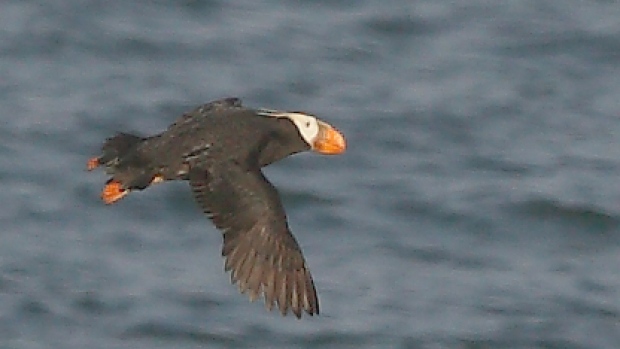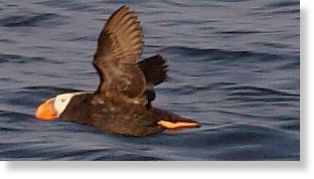
The first sighting of a tufted puffin on the east coast of North America in almost 200 years has people wondering how the common Pacific coast seabird made it to the Atlantic waters.
Ralph Eldridge, the lighthouse keeper on Machias Seal Island in the Bay of Fundy, spotted the bird and noted it was different from the thousands of Atlantic puffins found at the Canadian Wildlife Service sanctuary on the island.
"It stood out as different from our Atlantic puffins - larger, blacker but with a conspicuously orange beak and most notable, a very white face," said Eldridge in an email to CBC News.
Eldridge alerted Tony Diamond, a biology professor from the University of New Brunswick, who is on the island running the Atlantic Laboratory for Avian Research.
Diamond was able to view the bird in a large telescope and confirm the identification.
Tufted puffins are common on the Pacific coast from Alaska to northern California, breeding on offshore islands.
Jim Wilson, a naturalist, said the last recorded sighting of one in the North Atlantic was in the 1830s in Maine.
"To put it succinctly, if someone had asked me what the next bird - a new bird for New Brunswick might be - it would never have been a tufted puffin," said Wilson.
"The question that immediately springs to mind is how would this bird get here?
"Seabirds have to feed as they go," said Wilson.
"This is not a bird that is going to pick up and fly across the continent like a lot of other land birds might. It's got to stay near water in order to fuel itself for any kind of a flight."
Wilson hypothesizes it could have made its way to the Atlantic coast through the northwest passage or by flying all the way down the Pacific coast and around the southern tip of South America, then up the Atlantic coast of both South and North America.
"It certainly isn't going to go through the Panama canal, which is just a little strip through the woods," said Wilson.
"It's amazing how this bird would have possibly gotten here."

"It wouldn't be very hard to track down an escape and I'm sure some work will be done on that to be sure that it might not be an escape," he said.
Wilson said the bird photographed by Eldridge "absolutely" is a tufted puffin.
"There is no question, when you look at the photograph. there is nothing else possibly like it," he said.
"On the side of the head just about the eyes, there's these two kind of straw-coloured tufts of long feathers that kind of stream out like, I don't know - it looks almost like it's dressed for Halloween.
"It's an amazing looking bird and so distinctive there is nothing else that looks anything like it."
A tufted puffin is about 40 centimetres long, black in colour with a white face and a large orange beak.
Wilson said a tufted puffin was spotted in Britain in 2009 and there was a sighting - of possibly the same bird - in Sweden in the late 1990s.
"Those are the only other records other than the Pacific coast. so this is just a total mystery," said Wilson.
Wilson said there is no telling how long the tufted puffin will remain in the area.
"This is the breeding season. It's obviously in the company of a lot of other seabirds that are around Machias Seal Island," he said, adding that Atlantic puffins don't look the same as tufted puffins, but have the same habits and big orange beaks.
"It's probably looking for company and it may be looking for another tufted puffin," said Wilson.
Wilson said the tufted puffin looks healthy.
"If it's gotten this far, it's finding the food it needs," he said.
"It seems healthy. It looks in good shape, so it's obviously thriving. It's just gotten a little off course."



Reader Comments
to our Newsletter